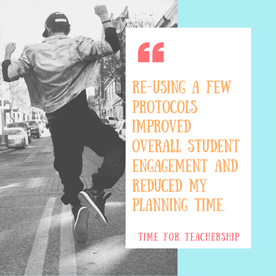|
Early in my teaching career, I planned lessons with the intention of coming up with as many different activities as possible. As I gained experience, I realized some activities (or “protocols”) worked better than others. I identified protocols that routinely engaged students in learning. I started re-using those, which improved overall student engagement and reduced my planning time. Talk about a win-win! What is a protocol? EL Education suggests a protocol skeleton includes:
Basically, a protocol is an activity. I use the term “protocol” because as a certified EL Education coach, I’m used to their terminology, and I like that it distinguishes the step-by-step nature of a protocol from a structureless activity. Use whatever language you prefer, just know these 3 components are important for student success! Why should I re-use protocols? EL Education, creators of this (totally free) research-based ELA curriculum, found that “Teachers are often most successful when they choose three to five protocols that anchor their instruction and focus on these.” When we re-use protocols that students are familiar with, students are more likely to participate, remain accountable, and spend more time learning (and less time trying to figure out the steps of a new protocol). It also promotes student independence and ownership of the learning process. Sometimes, teachers worry that students will become bored with the same protocol over and over. While that has happened to me, it typically happened months into heavy repetition. The key is to make the content or question students are grappling with engaging enough to hold their attention, so they are less focused on the protocol and more on what they’re talking about. Re-using protocols is particularly helpful for students with IEPs, as students with various dis/abilities (e.g., Learning Disability with a processing delay, Autism Spectrum Disorder) benefit from routine and consistency, as clear instructions reduce the cognitive load for students, freeing them up to focus on the learning (Impact). What are some protocols options? EL Education suggests having designated protocols for different purposes. I’ve slightly adapted their list to include the following: engaging with text, discussion, peer feedback, group decision-making, presenting, and independent work time rotation. For specific protocol ideas aligned to these purposes, consider what you already do that works well for your students. Build on your strengths! If you haven’t found any protocols that work well yet, I suggest looking at these great resources:
Try to identify 1 protocol per category and stick to these. You may want to structure your protocols to repeat regularly (e.g., on a particular day of the week, at a particular place in the arc of each unit). Make a list of your chosen protocols, and use this list when lesson planning to save time. What are your favorite protocols? How often do you repeat them?
1 Comment
Sara Glennon
1/28/2020 10:09:38 am
It's my first day of my semester, and this was very timely! I like the term protocols also. Write & pair share is one of my favorites. I also do what's called "Chalk Talk" here, with post-it notes. I will make a note of 4-5 of this to have in my toolkit this term! Great reminder.
Reply
Leave a Reply. |
Details
For transcripts of episodes (and the option to search for terms in transcripts), click here!
Time for Teachership is now a proud member of the...AuthorLindsay Lyons (she/her) is an educational justice coach who works with teachers and school leaders to inspire educational innovation for racial and gender justice, design curricula grounded in student voice, and build capacity for shared leadership. Lindsay taught in NYC public schools, holds a PhD in Leadership and Change, and is the founder of the educational blog and podcast, Time for Teachership. Archives
May 2024
Categories |





 RSS Feed
RSS Feed